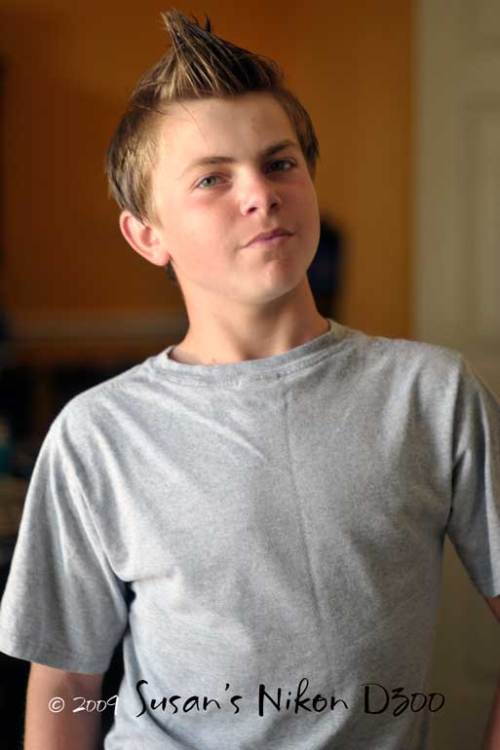
The sleeping beauty captured with the Nikon 85mm lens.
Last week’s Photo Friday dealt with advice about which kind of cameras to buy. Today the lenses take center stage. The best part of using a digital SLR is the ability to change lenses. There’s a large range of lenses to choose from, both the camera manufacturer’s own and third-party (like Sigma). Conventional photographer wisdom says to put your money into your glass—most manufacturers’ lenses work with their entire camera line (e.g., the fabulous Nikon 70-200mm lens can be used on the Nikon D40 to the D3). So when you upgrade, your lenses can go along for the ride.
Here’s my full disclosure right up front: I’m a total lens snob, thanks to Nikon’s gold lenses (all with a fixed aperture of f/2.8). Once I bought my first gold lens, the 70-200mm, and used it for action photography, I was hooked! The fact that it . . . and each of the other gold lenses I own . . . cost as much or more than the camera bothered me, but I soon realized that the gold lenses are difference-makers: They make people oooh and aaah over your photos. And sometimes buy them!
Canon, of course, has its own set of f/2.8 lenses that are equally spectacular. I’m also a huge fan of using the camera maker’s lenses, but that doesn’t mean that a third-party lens won’t fit the bill, too.

Taken with the Nikon 105mm lens, the f/2.8 helps the bokeh to pop!
Why am I such a fan of the f/2.8 (and the f/1.8s of the 50mm and 85mm) lenses? Because they’re fast, which means they let in a lot of light, making for faster shutter speeds when you don’t want to blur your subject(s). When you’re shooting in low-light conditions where you can’t use a flash, like in a gym or auditorium or early evening on the football field, a fast lens allows you to get shots that are almost impossible with a slower lens. Plus when used wide open (at f/2.8), that creamy bokeh (blurred background) makes your subject pop!
The 18-55mm lens that comes with almost every dSLR is slow. It’s a “variable aperture” lens. Unlike those f/2.8 lenses that allow you to use f/2.8 at 70mm and 200mm, a variable aperture lens typically is f/3.5-5.6. That means that at 18mm, the widest aperture you can use is f/3.5; at 55mm, it’s f/5.6. Little chance of bokeh at f/5.6 and even less chance of having a fast-enough shutter speed to capture action in low light.
But what if you don’t care about action photos? Why worry about having a fast lens if you just want to take pix of kids and flowers? See the photo at the top of the post? That was taken with the Nikon 85mm f/1.4 lens. Both the 50mm and 85mm lenses are superb in low-light conditions no matter what the subject. I like them for sneaking up on my kids both indoors and outdoors and because I prefer natural light to flash, which looks artificial to me. Just remember to increase your ISO if necessary to avoid blur (you don’t want your shutter speed to be too low).
Sidebar: You know how you can tell the top photo of my sleeping beauty #2 son was taken a couple years ago? No armpit hair!

Poindexter in natural light taken with the Nikon f/1.4 50mm lens
My fave lenses
I have five main lenses that I use with my Nikon D300. Each one has a specific purpose that makes it special to me. All are f/2.8 fixed-aperture except for the 50mm (f/1.4) and 85mm (f/1.4), and all are Nikon.
• The 17-55mm lens is my everyday lens. I love its supersaturated colors.
• The 105mm lens is the one I use for close-ups of flowers as well as for portraits and action shots. It’s surprising how versatile it can be.
• As I wrote above, the 50mm is great for low light indoors and outdoors when you don’t want to use flash.
• Gotta have my 85mm for indoor action as well as low-light, nonflash conditions.
• It may be heavy, and it’s definitely expensive, but I’ve used my 70-200mm all five years that I’ve been shooting with a digital SLR, and I love it! Great for outdoor action shots as well as portraits. Plus it’s an imposing piece of metal that almost screams “she actually knows what she’s doing!” even when I don’t (which is a little too often).
These are the lenses that work for me right now; they meet my photographic needs (although I think I see a wide-angle lens in my future). If you have a dSLR, and the kit lens isn’t getting the shots you want or need, look at upgrading. A great lens can make the difference between capturing a terrific shot and a mediocre one. Try one and see what happens!

 Subscribe to RSS Feed
Subscribe to RSS Feed